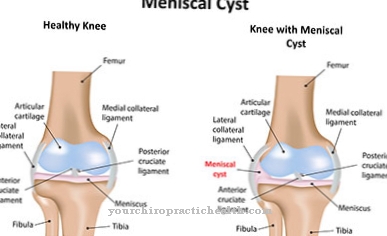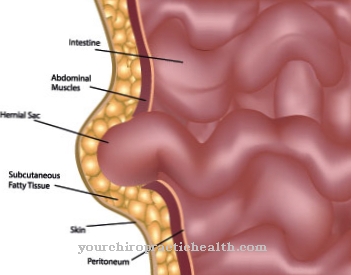At a Skull base fracture or. Base of skull fracture is a life-threatening injury to the head. It is caused by violence and can cause brain damage. A fracture of the base of the skull should not be confused with a concussion.
What is a skull base fracture?

The base of the skull forms the so-called brain skull. At a Skull base fracture the brain can therefore also be injured or cerebrospinal fluid leaks: Neurological disorders are a possible consequence.
The breaking edge runs along the bone seams; these are the places at which the individual skull plates initially grow together in infancy by means of connective tissue. The tissue becomes increasingly ossified in the course of life.
However, the skull sutures remain thinner than the solid skull plates and are therefore more prone to breakage. Most often, a skull base fracture occurs as a result of a break between the ear and the skull base or between the nose and the skull base.
causes
A Skull base fracture is the result of physical violence and can occur, for example, in traffic accidents. Car accidents in which one of the people involved hits the steering wheel or dashboard head-on are predestined for this type of injury.
This happens especially when the person is not wearing a seat belt. Another cause of a skull base fracture can be falls from a great height, in which it comes to impact on the head.
Less often, a skull base fracture occurs as a result of direct personal violence, i.e. a strong blow in the face. All of these variants can result in a lesion of the eye sockets, ethmoid, frontal sinuses, and sphenoid sinus.
Symptoms, ailments & signs
With a fractured skull base, the symptoms differ depending on whether the temporal bone is broken lengthways or crossways. A longitudinal fracture damages different nerves and vessels than a transverse fracture. If the bone is broken lengthways, there is a bruise from bleeding around the eyes. It can occur on one side (monocular hematoma) or on both sides (glasses hematoma).
In addition, the eyelids swell. If the bottom of the eyes is also broken, the eyes can sink deeper into the skull. Most of the time, the paranasal sinuses are also injured in the longitudinal fracture. This creates a bony step on the external auditory canal. In addition, the eardrum can tear and the ossicular chain disrupted, which leads to impaired hearing.
The olfactory nerves can also be injured. Paralysis of the facial nerve is rare in a longitudinal fracture, but more common in a transverse fracture. In the case of a transverse break, the ear in particular is damaged. Affected people can no longer hear anything and the sense of balance is disturbed. A bruise forms behind the ear.
In exceptional cases, an infection ascending through the ear canal can develop. In either type of skull base fracture, cerebrospinal fluid can flow out of the nose, ear, or mouth as a clear liquid. Rivulets of blood can also escape. In addition to these symptoms, patients suffer from severe headaches and impaired consciousness that can lead to unconsciousness.
Diagnosis & course
Through a Skull base fracture cerebrospinal fluid and blood may leak out. Since the skin usually remains intact despite the injury, the fluids do not seep out of a wound immediately: they make their way through the nose, mouth or ears.
Depending on where exactly the base of the skull breaks, the eyeball can be pushed forward or pulsate. The latter is caused by the penetration of blood from the internal carotid artery if it is damaged.
In addition, hematomas ("bruises") can develop in the eye sockets, which take on the shape of glasses. This phenomenon can also occur with other fractures in the head area. The break itself can easily be identified with the help of imaging techniques.
In addition to these visible changes, a skull base fracture can cause neurological disorders - temporarily or permanently. Disorders of consciousness such as loss of consciousness or a clouding of consciousness can be immediate consequences.
Secondary damage from a fracture of the base of the skull is also possible: if the blood penetrates the brain from an injured vein, further complications arise; up to failure of brain areas and the death of nerve cells.
Complications
In most cases, a skull base fracture is not associated with complications. This is especially true if no liquor (brain water) escapes and the meninges have not been affected. In some patients, however, the effects of the injury are severe, which in turn can have serious consequences and worsen the prognosis.
One of the dreaded consequences of a skull base fracture is the leakage of brain water. Liquid secretion flows out of the nose. If this is the case, the patient must be given antibiotics, because otherwise there is a risk of rising meningitis (meningitis). There is also a risk of a brain abscess, which is also the result of the liquorrhea.
Another possible complication is osteomyelitis, which causes inflammation of the skull bones. Another effect can be the development of a liquor fistula. A passage forms between the meninges and adjacent body structures in the outward direction. Pathogens such as bacteria can in turn penetrate through this inlet via the nose or ear.
A dreaded complication of the skull base fracture is the increase in intracranial pressure. The human brain reacts extremely sensitively to pressure. As a result, there is a risk of convulsions, loss of consciousness or life-threatening respiratory failure. Because there is a risk of the affected person suffocating, artificial ventilation is necessary. There is always an acute risk of suffocation if the base of the skull is fractured and the patient becomes unconscious.
When should you go to the doctor?
In the event of a fracture of the base of the skull, a doctor must be consulted immediately. This disease cannot self-heal and without treatment the bones can falsely fused together. In order to avoid further complications and damage to the brain, a doctor should always be consulted with a skull base fracture. The doctor should be consulted if the person concerned has a severe bruise on the head and has a very severe headache. Swollen eyelids also indicate the fracture of the base of the skull.
Especially after a fall or after another severe injury, these symptoms can indicate the base of the skull fracture. In some cases, hearing problems or paralysis of the face can indicate this break and should be examined by a doctor. It is also not uncommon for those affected to become unconscious or suffer from a disturbed sense of balance. In the case of a fracture of the base of the skull, a general practitioner can primarily be seen. In the event of very serious complaints or after an accident, however, an emergency doctor can be called or the hospital can be visited.
Treatment & Therapy
Bleeding as a result of a Skull base fracture can be prevented or stopped by immediate surgical intervention. The same applies to the release of cerebrospinal fluid.
Vessels may also have to be sutured, for example the internal carotid artery. Since the outer meninges are often torn when the base of the skull is broken, this must also be sewn afterwards. The actual break is carefully straightened and the break points are fixed with the help of various materials so that the skull can grow together again and the bones do not grow together or grow together crooked.
The material used for this is preferably the body's own (connective) tissue, since there is no risk of a repulsive reaction from the organism with it. The biological fibrin glue can also provide valuable services: It acts as a two-component glue. In rarer cases, metal plates need to be inserted into the skull.
If the eyes and / or ears have been affected by the fracture of the base of the skull, surgery is also carried out here. This is especially important in order to counteract the expected impairment of the visual or hearing sense at an early stage.
If the fracture of the base of the skull does not lead to leakage of cerebrospinal fluid or blood and there is no further damage, an operation is not necessary. In particular, breaks between the nose and the base of the skull are rather mild.
prevention
There a Skull base fracture arises from violent forces, there is no direct way to prevent it. However, general safety measures such as buckling up when driving can prevent any physical violence from occurring.
Aftercare
In most cases, a fractured skull base is associated with a concussion. It is therefore recommended that those affected take excessive care during the acute period. This includes avoiding unnecessary stress and avoiding sporting activities so that the blood pressure does not increase. Bowing of the head and long, hot baths should also be avoided.
Stays in the sun should also be avoided. Those affected should urgently avoid situations that could upset them. A balanced sleep rhythm is very important. Sufferers need to get enough sleep after the operation in order to be able to recover as quickly as possible.
If these points of aftercare are observed, not only can healing be accelerated, but also complications. Those affected should refrain from mechanical stress on the body until they have recovered completely. Any kind of head contact sports may not be practiced. These include, for example, martial arts, yoga and soccer.
In these sports there is too high a risk of further head injuries. If those affected ride a bike, wearing a helmet is mandatory. In the event of visual disturbances or headaches, those affected should always consult a doctor in order to rule out complications of the operation.
You can do that yourself
The fracture of the base of the skull is a trauma that must initially be part of medical treatment. But patient self-help is also very important in order not to jeopardize recovery and to ensure it is optimal.
Since the fracture of the base of the skull is often associated with a concussion, protection in the acute phase is essential. This not only includes physical rest and renouncing any sporting activity. It's also about avoiding activities that raise blood pressure. This includes bending your head as well as taking a hot bath or staying in the sun. Excitement should also be avoided in the acute phase. Getting enough sleep is important.
Even after the acute phase, self-help can not only accelerate regeneration, but also avoid complications.The fracture of the base of the skull often heals without any problems, but the skull must not be subjected to mechanical stress during this time. This includes, for example, avoiding such sports that could strain the head. This includes martial arts with full contact as well as the headstand in yoga or ball sports, which can put stress on the skull again with the headball in football or the possibility of a head hit with the ball in handball. When cycling or similar activities, the helmet is mandatory for the phase after the break. Headache or visual disturbances are reasons to see a doctor.

.jpg)
.jpg)


.jpg)






















